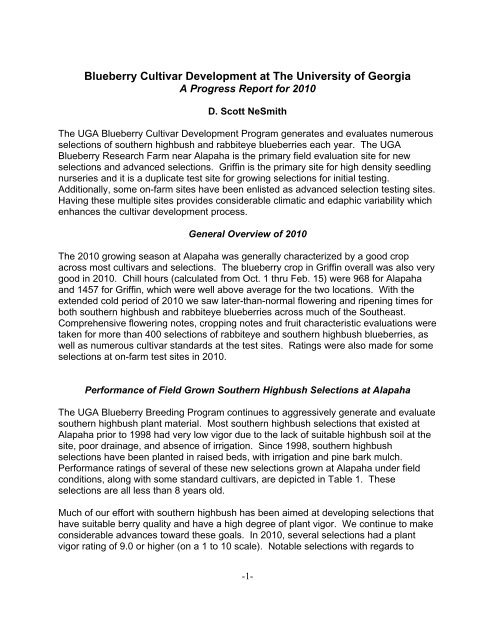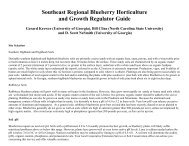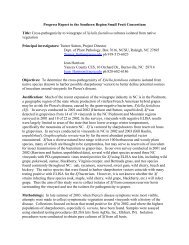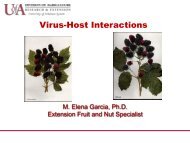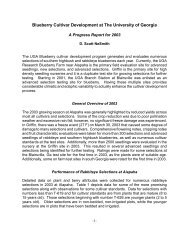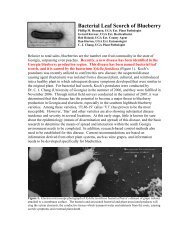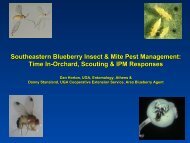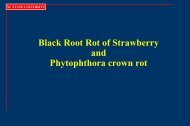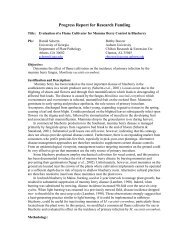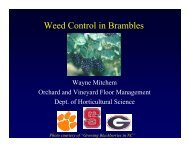Blueberry Cultivar Development at The University of Georgia
Blueberry Cultivar Development at The University of Georgia
Blueberry Cultivar Development at The University of Georgia
Create successful ePaper yourself
Turn your PDF publications into a flip-book with our unique Google optimized e-Paper software.
<strong>Blueberry</strong> <strong>Cultivar</strong> <strong>Development</strong> <strong>at</strong> <strong>The</strong> <strong>University</strong> <strong>of</strong> <strong>Georgia</strong>A Progress Report for 2010D. Scott NeSmith<strong>The</strong> UGA <strong>Blueberry</strong> <strong>Cultivar</strong> <strong>Development</strong> Program gener<strong>at</strong>es and evalu<strong>at</strong>es numerousselections <strong>of</strong> southern highbush and rabbiteye blueberries each year. <strong>The</strong> UGA<strong>Blueberry</strong> Research Farm near Alapaha is the primary field evalu<strong>at</strong>ion site for newselections and advanced selections. Griffin is the primary site for high density seedlingnurseries and it is a duplic<strong>at</strong>e test site for growing selections for initial testing.Additionally, some on-farm sites have been enlisted as advanced selection testing sites.Having these multiple sites provides considerable clim<strong>at</strong>ic and edaphic variability whichenhances the cultivar development process.General Overview <strong>of</strong> 2010<strong>The</strong> 2010 growing season <strong>at</strong> Alapaha was generally characterized by a good cropacross most cultivars and selections. <strong>The</strong> blueberry crop in Griffin overall was also verygood in 2010. Chill hours (calcul<strong>at</strong>ed from Oct. 1 thru Feb. 15) were 968 for Alapahaand 1457 for Griffin, which were well above average for the two loc<strong>at</strong>ions. With theextended cold period <strong>of</strong> 2010 we saw l<strong>at</strong>er-than-normal flowering and ripening times forboth southern highbush and rabbiteye blueberries across much <strong>of</strong> the Southeast.Comprehensive flowering notes, cropping notes and fruit characteristic evalu<strong>at</strong>ions weretaken for more than 400 selections <strong>of</strong> rabbiteye and southern highbush blueberries, aswell as numerous cultivar standards <strong>at</strong> the test sites. R<strong>at</strong>ings were also made for someselections <strong>at</strong> on-farm test sites in 2010.Performance <strong>of</strong> Field Grown Southern Highbush Selections <strong>at</strong> Alapaha<strong>The</strong> UGA <strong>Blueberry</strong> Breeding Program continues to aggressively gener<strong>at</strong>e and evalu<strong>at</strong>esouthern highbush plant m<strong>at</strong>erial. Most southern highbush selections th<strong>at</strong> existed <strong>at</strong>Alapaha prior to 1998 had very low vigor due to the lack <strong>of</strong> suitable highbush soil <strong>at</strong> thesite, poor drainage, and absence <strong>of</strong> irrig<strong>at</strong>ion. Since 1998, southern highbushselections have been planted in raised beds, with irrig<strong>at</strong>ion and pine bark mulch.Performance r<strong>at</strong>ings <strong>of</strong> several <strong>of</strong> these new selections grown <strong>at</strong> Alapaha under fieldconditions, along with some standard cultivars, are depicted in Table 1. <strong>The</strong>seselections are all less than 8 years old.Much <strong>of</strong> our effort with southern highbush has been aimed <strong>at</strong> developing selections th<strong>at</strong>have suitable berry quality and have a high degree <strong>of</strong> plant vigor. We continue to makeconsiderable advances toward these goals. In 2010, several selections had a plantvigor r<strong>at</strong>ing <strong>of</strong> 9.0 or higher (on a 1 to 10 scale). Notable selections with regards to-1-
plant vigor were 02-69, TH-906, TH-923, TH-940, TH-953, TH-1007, TH-1008, and TH-1010. While some <strong>of</strong> these selections may not become cultivars, they will be used inour breeding program to enhance overall plant vigor <strong>of</strong> our southern highbushgermplasm.Early ripening fruit continues to appeal to many <strong>Georgia</strong> blueberry growers. <strong>The</strong> Floridarelease ‘Star’ is currently a prominent standard cultivar, and it had 50% ripe fruit by May15 <strong>at</strong> Alapaha in 2010 under field conditions. ‘Rebel’ reached 50% ripe fruit by May 14.Although there were no damaging freezes during 2010, as mentioned previously theprolonged cold in the spring caused l<strong>at</strong>er-than-normal ripening times for all varieties andselections. <strong>The</strong> earliest ripening selection was TH-819, having 50% ripe fruit on May 4.This selection has been the earliest ripening for the past 3 to 4 years; however it tendsto flower early as well, which would require spring frost protection for successfulproduction. We have advanced this selection to final stages <strong>of</strong> testing. Other notableearly ripeing selections in 2010 were TH-944, TH-948, and TH-953. <strong>The</strong>se selectionsripened 4 to 9 days ahead <strong>of</strong> Star <strong>at</strong> the Alapaha test site.<strong>The</strong> fruit development period (FDP) <strong>of</strong> blueberries, defined as the days from flowering toripening, can be very important. A short FDP can result in l<strong>at</strong>er flowering, which helpsto avoid pressure from spring freezing temper<strong>at</strong>ures, while achieving early ripeningd<strong>at</strong>es which can bring higher market prices. Notable selections with l<strong>at</strong>e flowering andearly ripening were TH-828B, TH-923, and TH-948. <strong>The</strong>se selections flowered 5 to 15days after Star and Rebel, and ripened as early or earlier than the standard varieties.We continue to try and develop southern highbush varieties with short FDP, and theseand other selections will be used in our breeding effort to improve this trait.Berry size is important, and is especially <strong>at</strong>tractive for improving efficiency <strong>of</strong> handharvesting. Currently, ‘Emerald’ is the standard cultivar grown in <strong>Georgia</strong> with thelargest berry size, although the recent UGA release ‘Camellia’ also has impressive berrysize. Several selections grown under field conditions <strong>at</strong> Alapaha during 2010 had berrysize as large or larger than ‘Emerald’. <strong>The</strong>se included TH-895, TH-898, TH-920, TH-931, TH-940, TH-948, TH-953, TH-1008, and TH-1010. Many <strong>of</strong> these large fruitedselections also had other desirable traits such as good firmness and/or flavor. We havepropag<strong>at</strong>ed several <strong>of</strong> these selections for advanced testing, and we will continue toevalu<strong>at</strong>e these over the next few years for yield consistency and overall long term planthealth.-2-
Table 1. R<strong>at</strong>ings <strong>of</strong> some fruit and plant characteristics <strong>of</strong> field grown southernhighbush blueberry cultivars and selections from Alapaha during 2010.Selection orVarietyD<strong>at</strong>e <strong>of</strong>50%FloweringD<strong>at</strong>e <strong>of</strong>50%RipeningBerrySizeBerryScarBerryColorBerryFirmnessBerryFlavorCropLoadPlantvigorCamellia 19-Mar 17-May 9.0 7.0 9.3 7.0 8.0 6.0 10.0Emerald 5-Mar 19-May 8.8 7.3 7.0 7.3 6.8 8.0 6.8Palmetto 15-Mar 10-May 7.0 7.0 7.0 8.0 8.5 6.0 7.0Rebel 12-Mar 14-May 7.8 7.0 7.3 7.5 6.5 10.0 9.0Star 16-Mar 15-May 7.5 6.8 7.3 7.0 6.8 9.3 6.0Suziblue 15-Mar 11-May 8.5 7.5 7.3 7.5 7.3 8.0 8.502-69 30-Mar 23-May 8.2 8.0 8.0 8.0 8.0 6.0 9.0TH-819 5-Mar 4-May 7.5 7.5 7.3 7.3 7.8 6.5 7.5TH-828B 20-Mar 15-May 8.3 7.3 8.5 8.0 8.0 7.0 7.5TH-888 6-Apr 19-May 7.3 6.5 9.0 6.5 8.8 5.0 5.0TH-889 31-Mar 23-May 7.5 8.0 9.5 8.5 7.8 8.0 8.0TH-895 29-Mar 23-May 8.5 7.0 7.8 7.0 7.0 7.5 8.0TH-898 20-Mar 19-May 8.5 7.8 9.0 7.5 8.0 5.5 6.8TH-905 18-Mar 16-May 8.0 7.5 8.0 8.0 8.3 8.0 8.5TH-906 11-Mar 19-May 7.5 7.5 8.0 7.5 7.5 7.5 9.5TH-917 19-Mar 19-May 8.3 8.0 8.0 8.0 7.5 6.5 8.5TH-919 17-Mar 13-May 7.3 7.0 7.3 7.5 7.8 7.0 8.0TH-920 24-Mar 16-May 9.0 7.5 9.3 7.3 8.0 6.0 8.5TH-921 20-Mar 14-May 7.0 7.5 7.5 7.8 7.8 9.5 8.5TH-923 1-Apr 15-May 8.0 7.8 7.8 6.8 8.5 4.5 10.0TH-931 25-Mar 22-May 8.5 8.0 7.5 7.0 7.5 6.0 7.0TH-934 30-Mar 29-May 7.0 8.0 8.0 8.8 8.0 7.0 7.5TH-940 20-Mar 24-May 8.8 7.3 8.5 7.5 8.0 8.0 10.0TH-944 8-Mar 6-May 7.5 6.5 7.0 6.5 7.5 6.0 6.5TH-948 29-Mar 11-May 9.2 7.0 8.0 8.3 8.3 6.0 6.0TH-953 11-Mar 11-May 8.8 7.5 8.5 8.0 8.5 6.0 10.0TH-1007 10-Mar 15-May 8.3 7.8 7.5 7.5 8.0 6.0 10.0TH-1008 14-Mar 19-May 9.2 7.5 8.5 8.0 7.5 5.5 9.0TH-1010 20-Mar 17-May 9.2 7.5 8.5 7.5 7.0 7.0 9.5-3-
Performance <strong>of</strong> Field Grown Southern Highbush Selections <strong>at</strong> GriffinAll <strong>of</strong> the southern highbush plants growing in Griffin are 7 years old or less. While thetest site is not considered very suitable for southern highbush production, we have beenable to successfully grow many <strong>of</strong> our selections in the red Piedmont soil with pine barkmulch and irrig<strong>at</strong>ion. Table 2 lists d<strong>at</strong>a for several <strong>of</strong> the highbush selections in Griffin.Most <strong>of</strong> these were evalu<strong>at</strong>ed <strong>at</strong> Alapaha as well. Selections th<strong>at</strong> demonstr<strong>at</strong>edoutstanding plant vigor <strong>at</strong> the Griffin site included TH-828B, TH-888, TH-923, TH-931,TH-948, TH-953, TH-1007, and TH-1010. Four <strong>of</strong> these selections also had very goodplant vigor <strong>at</strong> Alapaha, suggesting a wide range <strong>of</strong> soil adapt<strong>at</strong>ion. ‘Camellia’, a recentUGA release, also had very good plant vigor in Griffin as it did <strong>at</strong> Alapaha.Berry size <strong>of</strong> ‘Emerald’ and ‘Camellia’ were largest among the standard cultivars inGriffin during 2010. Several newer selections also had very large berry size. <strong>The</strong>seincluded 02-69, TH-895, TH-898, TH-920, TH-931, TH-940, TH-949, TH-953, TH-1008,and TH-1010. Interestingly, all <strong>of</strong> these selections also had large berry size <strong>at</strong> theAlapaha test site, suggesting the selections have a good tendency for sizing <strong>of</strong> fruitacross environments. <strong>The</strong>se large fruited selections will be used in the breedingprogram for improving overall berry size and quality <strong>of</strong> the germplasm.In Griffin during 2010, berry firmness was measured for several southern highbushselections using a FirmTech II firmness tester. This instrument basically records theforce (g) required to deflect or compress berries a certain amount (measured in mm).<strong>The</strong> higher the units (g/mm), the more firm berries are. <strong>The</strong> standard instrumentsettings were 50 g minimum and 250 g maximum force. Table 3 depicts firmnessvalues <strong>at</strong> harvest (first 25% <strong>of</strong> ripe fruit) for several cultivars and selections, along withaverage berry weights <strong>of</strong> samples. <strong>The</strong> selections TH-828B, TH-896, TH-921, TH-934,TH-977, and TH-1003 all had firmness values <strong>of</strong> 200 or gre<strong>at</strong>er which is consideredvery firm. Again, berry size measurements indic<strong>at</strong>e some very large fruited selections,with TH-895, TH-931, TH-948, and TH-953 all exceeding a 3.0 g per berry average fruitweight.While flavor is subjective, we are trying to consider this more in our evalu<strong>at</strong>ions.‘Palmetto’ has become the flavor standard in our program. <strong>The</strong> selections TH-888, TH-905, TH-919, and TH-953 were all r<strong>at</strong>ed to have very good flavor in Griffin. This addedbenefit could make these selections desirable as cultivars if they hold up to continuedtesting.-4-
Table 2. R<strong>at</strong>ings <strong>of</strong> some fruit and plant characteristics <strong>of</strong> field grown southernhighbush blueberry cultivars and selections from Griffin during 2010.Selection orVarietyD<strong>at</strong>e <strong>of</strong>50%FloweringD<strong>at</strong>e <strong>of</strong>50%RipeningBerrySizeBerryScarBerryColorBerryFirmnessBerryFlavorCropLoadPlantvigorCamellia 5-Apr 31-May 9.0 7.0 8.5 7.0 8.0 7.0 10.0Emerald 22-Mar 30-May 8.8 7.0 8.0 7.8 6.8 5.0 6.0Palmetto 30-Mar 23-May 7.0 6.8 6.5 7.5 8.8 7.5 9.0Rebel 30-Mar 20-May 7.3 7.3 7.3 7.3 6.0 8.0 6.5Star 2-Apr 24-May 7.5 7.0 7.5 7.0 7.0 8.5 9.5Suziblue 31-Mar 19-May 8.0 7.3 7.0 7.0 7.5 9.0 8.002-69 6-Apr 28-May 8.8 8.0 8.0 8.0 7.3 6.0 8.0TH-819 27-Mar 16-May 7.0 7.5 7.5 7.0 7.0 7.0 6.0TH-828B 2-Apr 26-May 8.5 7.3 8.5 8.0 7.5 7.0 9.0TH-888 6-Apr 23-May 8.0 6.5 8.0 7.0 9.3 6.0 8.5TH-889 2-Apr 30-May 8.3 8.5 9.5 7.5 8.0 7.0 8.0TH-895 6-Apr 6-Jun 9.0 8.0 8.0 7.0 7.5 5.0 8.0TH-898 3-Apr 9-Jun 9.0 7.3 8.5 8.3 8.3 5.5 8.0TH-905 30-Mar 26-May 8.0 7.5 8.5 8.8 8.5 5.5 8.0TH-906 30-Mar 28-May 7.5 7.0 8.0 7.0 8.0 6.5 8.0TH-917 3-Apr 2-Jun 8.0 7.0 8.0 8.3 8.0 6.0 8.0TH-919 3-Apr 25-May 7.5 6.8 7.8 7.3 8.5 5.0 8.0TH-920 4-Apr 29-May 9.0 7.0 9.0 7.0 7.3 6.0 7.0TH-921 2-Apr 27-May 8.0 7.5 8.5 7.0 8.0 5.0 8.0TH-923 7-Apr 27-May 8.5 7.3 7.5 6.5 8.0 6.0 9.0TH-931 4-Apr 5-Jun 9.0 8.0 9.5 7.3 8.0 6.5 8.5TH-934 6-Apr 5-Jun 8.0 8.0 8.5 7.8 7.5 5.0 7.8TH-940 3-Apr 1-Jun 8.8 7.3 8.5 8.3 7.5 7.0 8.0TH-944 27-Mar 15-May 8.3 7.0 6.8 6.8 7.5 5.5 7.0TH-948 4-Apr 23-May 9.3 7.5 8.0 8.0 8.0 6.0 10.0TH-953 29-Mar 24-May 9.3 6.8 7.0 7.5 8.5 6.0 8.5TH-1007 30-Mar 25-May 8.5 7.3 7.0 7.5 7.5 5.0 8.5TH-1008 28-Mar 27-May 9.0 8.3 8.5 7.5 7.3 5.0 7.5TH-1010 2-Apr 21-May 9.0 8.0 8.5 7.5 6.5 7.0 9.0-5-
Table 3. Berry weight and firmness <strong>at</strong> harvest for several southern highbush blueberrycultivars and selections grown in Griffin, GA during 2010. Firmness was measuredusing a FirmTech II device.Selection orcultivarBerry weight(g)Berryfirmness(g/mm)Camellia 2.93 150Emerald 2.41 165Legacy 1.85 176Rebel 2.33 187Star 1.60 198Suziblue 2.13 19702-69 2.92 180TH-780 2.27 195TH-828B 2.25 210TH-889 2.24 190TH-895 3.04 142TH-896 3.00 205TH-905 2.12 180TH-906 2.00 156TH-919 1.60 185TH-920 2.35 169TH-921 2.05 200TH-931 3.36 198TH-934 2.97 200TH-948 3.15 165TH-953 3.67 163TH-977 2.40 205TH-1003 1.76 200TH-1007 2.12 162TH-1008 2.07 164TH-1010 2.36 141-6-
Performance <strong>of</strong> Rabbiteye Selections <strong>at</strong> AlapahaDetailed d<strong>at</strong>a on plant and berry <strong>at</strong>tributes were collected for various rabbiteyeselections grown under field conditions in 2010 <strong>at</strong> Alapaha. Table 4 depicts d<strong>at</strong>a forsome <strong>of</strong> the more promising selections along with observ<strong>at</strong>ions for some cultivarstandards. We continue to be interested in early ripening rabbiteye selections in the‘Climax’ and ‘Premier’ ripening window (or earlier). ‘Climax’ and ‘Premier’ had 50%ripening June 9 to 11 this year. ‘Alapaha’ (UGA 2001 release) ripened June 7.‘Alapaha’ fruit tend to be smaller than we would like, but ripening is concentr<strong>at</strong>ed, andyields continue to be good. ‘Vernon’ (UGA 2004 release) was also 50% ripe by June 7,which was earlier than ‘Climax’ and ‘Premier’. ‘Vernon’ also has good berry size. Aswith southern highbush, the prolonged cold period in the early spring caused l<strong>at</strong>erripening for all rabbiteye varieties and selections. However, there were severalselections th<strong>at</strong> still had early 50% ripe d<strong>at</strong>es rabbiteyes. <strong>The</strong>se included 02-63 (June6), 03-04 (June 3), T-743 (June 1), T-957 (May 29), T-959 (June 7), T-961 (June 4), andT-965 (June 5). Some <strong>of</strong> these had light crops, but most had large to very large berrysize which would be very favorable for hand-harvesting. Most notable was T-959, whichcontinues to have the largest berries we have seen on a rabbiteye. Figures 1 and 2show yields and berry size for two <strong>of</strong> the selections from plants <strong>at</strong> the AlapahaResearch Farm for 2010 along with variety standards. <strong>The</strong>se plants were only 4 yearsold (established Fall 2006). T-959 particularly had high yield (exceeding 23 lbs perplant), and had impressive berry size over most <strong>of</strong> the season. We submitted T-959 forrelease this year and it was approved. This new variety should be available fordistribution to licensees in 2011.Performance <strong>of</strong> Rabbiteye Selections <strong>at</strong> GriffinMany <strong>of</strong> the rabbiteye selections listed above for the Alapaha loc<strong>at</strong>ion also performedwell <strong>at</strong> the Griffin test site in 2010 (Table 5). All plants <strong>at</strong> the Griffin test site are young(7 years old or less), and all plants are irrig<strong>at</strong>ed and mulched with bark. In Griffin,‘Climax’ and ‘Premier’ ripened June 19 during 2010. Again, the UGA release ‘Alapaha’performed well in comparison, as did ‘Vernon’. Several selections th<strong>at</strong> ripened before‘Climax’ in Griffin (similar list as from Alapaha site) were 02-63, 03-04, T-743, T-957, T-961, and T-965. T-959 ripened <strong>at</strong> a similar time as Climax and Premier in Griffin. Most<strong>of</strong> the early selections had larger berry size than ‘Climax’. We will continue to evalu<strong>at</strong>ethese selections <strong>at</strong> both Griffin and Alapaha, as well as <strong>at</strong> other loc<strong>at</strong>ions.For l<strong>at</strong>er season berries, Brightwell ripened in Griffin (50% ripe) on June 30,Powderblue on June 30, and Ochlockonee on July 12. Some selections <strong>of</strong> interest inthe l<strong>at</strong>er ripening time frame include T-968, T-1016, and T-1019. <strong>The</strong>se selections,along with other l<strong>at</strong>er selections were propag<strong>at</strong>ed for advanced trials this year. Also,some <strong>of</strong> our up and coming young selections have several th<strong>at</strong> are l<strong>at</strong>er ripening. Our-7-
emphasis has been geared toward earlier varieties, but we need some l<strong>at</strong>er ripeningvarieties as well to replace Brightwell and Powderblue.As with the southern highbush in Griffin, we also measured berry firmness and size forseveral rabbiteye selections and cultivar standards in 2010 (Table 6). Berry d<strong>at</strong>a weretaken from random samples when <strong>at</strong> least 25% <strong>of</strong> fruit were ripe for each selection. <strong>The</strong>results show most rabbiteye are firm (180-200 g/mm), with the major exception beingPremier (165 g/mm), which is considered among the s<strong>of</strong>ter commercial varieties. Pastresearch has suggested th<strong>at</strong> a firmness value <strong>of</strong> 170-175 g/mm is the minimum for aberry to be successfully mechanically harvested, and Premier is on th<strong>at</strong> threshold.Grower experience has shown indeed Premier can become too s<strong>of</strong>t to harvest with amachine. We have several selections th<strong>at</strong> are very firm (> 200 g/mm). Notables forfirmness were T-959 (260 g/mm) and T-968 (258 g/mm). In addition to firmnessimprovements, we are also are making considerable progress in developing larger sizein the rabbiteye berries, with many selections exceeding 2 g/berry in weight. T-957 andT-959 have exceptional berry size, with both <strong>of</strong> these exceeding 3 g/berry. This largeberry size can improve hand harvesting efficiency, and may have increased consumerappeal in select markets. We are continuing trials with these selections, and areincorpor<strong>at</strong>ing the larger fruited germplasm into our breeding efforts.Similar to past years, several rabbiteye cultivars and selections in Griffin were evalu<strong>at</strong>edfor fruit cracking in response to rainfall by using a protocol th<strong>at</strong> involved soaking berriesovernight in distilled w<strong>at</strong>er (Table 6). We c<strong>at</strong>egorized cracking for individual berries asslight, moder<strong>at</strong>e, and severe. Those berries with none or only slight cracking wereconsidered commercially useful, whereas berries th<strong>at</strong> had moder<strong>at</strong>e to severe crackingwere considered commercially unacceptable. As in the past, the early season cultivars‘Alapaha’ and ‘Premier’ showed minimal fruit cracking problems, and the large fruitedselection T-957 showed a similar response. Some <strong>of</strong> the selections we tested did notperform well in the fruit-cracking test, including T-743, T-959 and T-961. Each <strong>of</strong> theseselections had a very nice berry with regards to size and firmness; however, thecracking response could present problems. T-959 has the largest rabbiteye berry sizewe have observed, and as mentioned earlier was approved for release for 2011. Weexpect the large berry size and early ripening time will still stir interest in this newvariety, even with it being susceptible to cracking.-8-
Table 4. R<strong>at</strong>ings <strong>of</strong> some fruit and plant characteristics <strong>of</strong> field grown rabbiteyeblueberry cultivars and selections from Alapaha during 2010.Selection orVarietyD<strong>at</strong>e <strong>of</strong>50%FloweringD<strong>at</strong>e <strong>of</strong>50%RipeningBerrySizeBerryScarBerryColorBerryFirmnessBerryFlavorCropLoadPlantvigorAlapaha 28-Mar 7-Jun 6.5 7.5 7.0 7.0 8.0 7.0 8.0Brightwell 1-Apr 24-Jun 6.8 7.5 7.0 7.5 6.8 9.0 10.0Climax 29-Mar 11-Jun 6.5 7.0 7.0 7.8 6.8 6.0 7.0Ochlockonee 7-Apr 7-Jul 7.5 8.0 7.8 8.0 8.0 9.0 9.0Powderblue 1-Apr 27-Jun 6.8 8.0 8.0 7.0 7.2 6.0 9.0Premier 3-Apr 9-Jun 8.0 7.5 7.0 7.0 7.5 2.0 10.0Vernon 31-Mar 7-Jun 8.0 8.0 7.5 8.0 8.0 5.0 9.002-63 2-Apr 6-Jun 8.5 8.5 7.5 8.0 8.5 6.0 9.003-04 1-Apr 3-Jun 7.5 7.2 7.5 7.0 7.8 5.0 10.0T-743 28-Mar 1-Jun 8.5 8.0 8.5 8.5 9.0 2.0 10.0T-957 28-Mar 29-May 8.2 8.5 7.5 8.5 8.0 6.0 9.5T-959 30-Mar 7-Jun 9.2 8.0 7.0 8.5 7.0 6.0 10.0T-961 29-Mar 4-Jun 8.0 7.5 7.5 7.5 7.3 6.0 7.5T-965 22-Mar 5-Jun 8.0 8.0 6.8 8.0 8.0 9.0 10.0T-968 31-Mar 16-Jun 8.5 8.0 7.5 7.3 7.0 4.0 8.0T-1015 28-Mar 7-Jun 8.5 9.0 7.5 9.5 8.5 1.5 10.0T-1016 28-Mar 14-Jun 8.0 8.5 7.0 9.0 8.0 3.0 9.5T-1017 4-Apr 20-Jun 8.0 6.8 6.8 10.0 7.0 3.5 8.5T-1019 31-Mar 17-Jun 8.0 8.8 6.8 8.5 7.5 5.0 8.0-9-
25.020.0Yield (lbs/bush)15.010.0VernonT-959T-965AlapahaBrightwell5.00.012-May 22-May 1-Jun 11-Jun 21-Jun 1-Jul 11-JulD<strong>at</strong>eFigure 1. Yield <strong>of</strong> two rabbiteye selections and three standard varieties <strong>at</strong> Alapaha for2010.3.53.0Berry weight (g2.52.01.51.0VernonT-959T-965AlapahaBrightwell0.50.024-May 31-May 7-Jun 14-Jun 21-Jun 28-Jun 5-JulD<strong>at</strong>eFigure 2. Average berry weight for two rabbiteye selections and three standardvarieties over several harvests <strong>at</strong> Alapaha for 2010.-10-
Table 5. R<strong>at</strong>ings <strong>of</strong> some fruit and plant characteristics <strong>of</strong> field grown rabbiteyeblueberry cultivars and selections from Griffin during 2010.Selection orVarietyD<strong>at</strong>e <strong>of</strong>50%FloweringD<strong>at</strong>e <strong>of</strong>50%RipeningBerrySizeBerryScarBerryColorBerryFirmnessBerryFlavorCropLoadPlantvigorAlapaha 8-Apr 17-Jun 7.0 8.0 6.8 7.0 8.0 7.5 8.5Brightwell 9-Apr 30-Jun 6.5 7.5 7.3 8.3 6.8 10.0 8.5Climax 6-Apr 19-Jun 7.0 7.0 7.0 7.5 7.0 7.0 7.5Ochlockonee 12-Apr 12-Jul 7.0 7.5 7.0 7.5 7.5 9.5 10.0Powderblue 8-Apr 30-Jun 6.5 8.0 8.3 7.5 6.8 8.0 8.0Premier 6-Apr 19-Jun 7.5 7.5 7.5 7.0 7.5 4.5 7.5Vernon 9-Apr 17-Jun 8.5 7.8 7.0 8.0 8.0 6.0 9.002-63 10-Apr 16-Jun 8.5 8.0 7.5 8.0 7.5 5.0 7.503-04 9-Apr 16-Jun 8.5 8.5 7.0 8.0 8.5 5.0 7.5T-743 6-Apr 8-Jun 8.0 7.5 8.0 7.5 8.5 2.5 9.5T-957 9-Apr 12-Jun 8.5 7.0 7.0 8.0 8.0 7.5 8.5T-959 8-Apr 19-Jun 9.2 8.0 7.3 8.8 7.0 6.5 10.0T-961 8-Apr 15-Jun 7.8 7.5 8.0 8.5 8.0 5.5 8.0T-965 6-Apr 17-Jun 8.5 7.5 7.0 7.5 8.0 8.0 8.0T-968 9-Apr 25-Jun 8.2 8.8 8.0 8.0 8.0 5.5 8.0T-1015 7-Apr 25-Jun 8.5 8.8 7.0 9.3 8.0 3.0 9.0T-1016 7-Apr 27-Jun 8.5 8.5 7.0 8.5 8.0 4.5 9.0T-1017 8-Apr 24-Jun 7.5 6.8 6.8 8.8 7.5 6.0 9.0T-1019 10-Apr 23-Jun 8.0 7.5 6.8 8.0 8.0 6.0 8.0-11-
Table 6. Berry firmness, average berry weight, and percent fruit cracking <strong>of</strong> severalrabbiteye blueberry selections from the <strong>Blueberry</strong> <strong>Cultivar</strong> <strong>Development</strong> Program <strong>at</strong> theGriffin, GA loc<strong>at</strong>ion during 2010.SelectionBerryfirmness(g/mm)AverageberryWeight(g)Moder<strong>at</strong>e toseverecracking(%)Alapaha 210 1.57 3Brightwell 245 1.01 2Climax 206 1.56 9Columbus 190 2.44 0Premier 165 2.00 3Powderblue 232 1.08 0Ochlockonee 215 1.56 0Vernon 200 2.20 803-06 230 1.60 10T-743 215 2.08 20T-957 183 3.10 0T-959 260 3.15 26T-961 205 2.44 21T-965 215 2.70 9T-968 258 2.24 6-12-
Goals <strong>of</strong> <strong>The</strong> UGA <strong>Blueberry</strong> <strong>Cultivar</strong> <strong>Development</strong> Program for 2011Plans for the year 2011 are to continue aggressively evalu<strong>at</strong>ing seedlings, selections,and advanced selections <strong>of</strong> both commercial and ornamental blueberries (which hasbecome an additional focus <strong>of</strong> our effort in the past few years). More than 50 newcrosses were made during 2010, and 2500 to 3500 seedlings will be gener<strong>at</strong>ed fromthese crosses in 2011. <strong>The</strong>se seedlings will be planted in a seedling nursery during thesummer <strong>of</strong> 2011 to be grown for future evalu<strong>at</strong>ions. More than 2500 seedlings wereplanted in 2009, and more than 3500 new seedlings were planted in a seedling nurseryduring 2010. <strong>The</strong>se seedlings will be screened after 3 years for fruit and plantcharacteristics suitable for both commercial and ornamental production. <strong>The</strong> mostpromising seedlings will be identified as selections for further evalu<strong>at</strong>ion (estim<strong>at</strong>ed tobe 3 to 5% <strong>of</strong> total seedlings). In 2010, 200 new selections (a mixture <strong>of</strong> commercialand ornamental m<strong>at</strong>erial) were made from seedlings <strong>of</strong> crosses made by the UGAprogram in the last 3 years. <strong>The</strong>se were propag<strong>at</strong>ed, and multiple plants will beestablished <strong>at</strong> Alapaha and Griffin in 2011 for further evalu<strong>at</strong>ion. <strong>The</strong>se new selectionswill be added to the several hundred selections currently growing <strong>at</strong> these loc<strong>at</strong>ions th<strong>at</strong>will be evalu<strong>at</strong>ed during 2011 for possible design<strong>at</strong>ion as advanced selections.In 2009 and 2010, several selections were identified as advanced selections and werepropag<strong>at</strong>ed. <strong>The</strong>se will be further evalu<strong>at</strong>ed in 2011 for potential as cultivars, and some<strong>of</strong> the advanced selections will be distributed to both commercial and ornamentalcooper<strong>at</strong>ors to assist in the final evalu<strong>at</strong>ion process. Several commercial andornamental advanced selections were distributed to cooper<strong>at</strong>ors in 2010 to begin thefinal phase <strong>of</strong> testing for their potential as cultivar releases. D<strong>at</strong>a from these trials willbe collected beginning in 2011 and will continue through 2016. Evalu<strong>at</strong>ions <strong>of</strong> thecommercial advanced selections will include fruit characteristics, plant growthcharacteristics, flowering times, and yields (when possible). For the ornamentalselections evalu<strong>at</strong>ions will include plant growth habit, flowering times, ornamentalappeal, and nursery container growth.In 2008 we established southern highbush advanced selection plots <strong>at</strong> the AlapahaFarm to evalu<strong>at</strong>e their potential to be mechanically harvested for the commercialproduction industry. An additional trial was established in 2010 as well. This is a gre<strong>at</strong>need for <strong>Georgia</strong> growers since hand-harvest labor issues are becoming morecumbersome for the industry. <strong>The</strong>se specialty advanced selection trial blocks will beginto be evalu<strong>at</strong>ed in 2011 and will take up to 5 years to complete.In 2005 we initi<strong>at</strong>ed a pilot effort for selecting blueberries for the edibleornamental/home garden consumer. <strong>The</strong> effort quickly gained momentum from theornamental nursery industry, and is thus being expanded and becoming a second majoreffort <strong>of</strong> our UGA <strong>Blueberry</strong> Breeding Program. We are seeking a diversity <strong>of</strong> planttypes for this new industry th<strong>at</strong> are specifically ornamental in n<strong>at</strong>ure. Traits beingsought include compact plant habits, colorful berries, novel plant characteristics, and-13-
<strong>at</strong>tractive foliage. <strong>Blueberry</strong> varieties for these markets do not need typical commercialproduction <strong>at</strong>tributes such as concentr<strong>at</strong>ed ripening and fruit quality traits for longdistant shipping. <strong>The</strong>refore, this entire effort is substantially different than thecommercial production evalu<strong>at</strong>ions we have done for years. To this end, we havebegun to partner with some leading ornamental nurseries to provide us input and testour edible ornamental selections for their potential growing and marketing conditions.We have 2 released varieties th<strong>at</strong> are being p<strong>at</strong>ented and licensed to ornamentalnurseries. <strong>The</strong> first <strong>of</strong> these varieties will be part <strong>of</strong> a marketing campaign in 2011. Wenow have more than 80 ornamental blueberry selections we are evalu<strong>at</strong>ing. We haveinterest in this program from several large nurseries, some <strong>of</strong> which visited our programfor the first time in 2010.-14-


